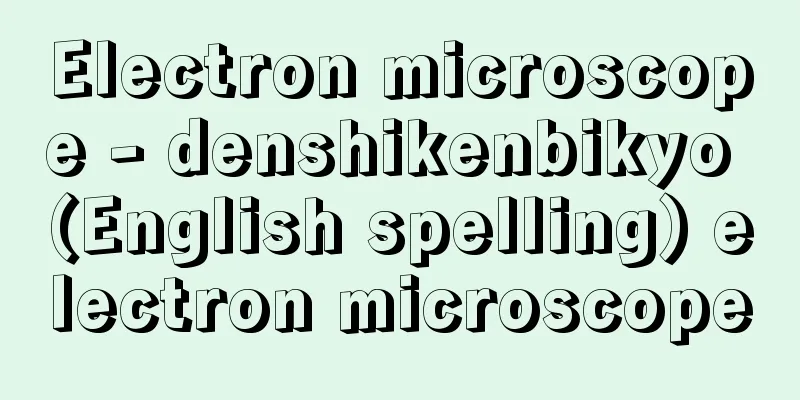Electron microscope - denshikenbikyo (English spelling) electron microscope

|
An instrument that uses electrons instead of light to create a magnified image of an object. The unique feature of an electron microscope is that it can see tiny objects that cannot be seen with an optical microscope. Cells and bacteria can be seen with an optical microscope, but only their rough outlines can be seen; only an electron microscope can reveal their internal microscopic structure. The resolution of an optical microscope is at most 0.4 micrometers. This is because the wavelength of light waves is about that size, and no matter how much lenses are improved, this is a limit that cannot be overcome in principle. Electron microscopes are able to overcome this limit because the wavelength of electron waves is much shorter than that of light waves. There are many types of electron microscopes, but the most common are either transmission or scanning electron microscopes. These are commercially available as scientific instruments and are widely used in engineering, medicine, and agriculture. (1) Transmission Electron Microscope This type is abbreviated to TEM, which is an abbreviation of the English "transmission electron microscope." Electrons emitted from a filament are accelerated to hundreds of thousands of volts, focused, and irradiated onto a thin sample. The transmitted electron beam image is successively magnified by electron lenses (the standard type has three lenses: objective, intermediate, and projection), and the final image is observed on a fluorescent screen and photographed by a camera. The path of the electron beam is, of course, all vacuumed. All of the lenses used here are magnetic field type electron lenses, which in principle are coils with the electron beam as their axis. By increasing or decreasing the current (direct current) passed through them, it is possible to adjust the focus and change the magnification. The sample can be inserted from the atmosphere into the vacuum through a pre-evacuation chamber in less than a minute. The sample is moved back and forth and left and right to find the desired field of view, and the magnification (1000x to 1 millionx) is appropriately selected for observation and photography. Many adjustments are required during this process, and high magnification requires advanced techniques. The equivalent of the glass slide in an optical microscope is a large number of small holes with a diameter of 0.1 mm. A thin film of amorphous carbon (about 10 nanometers thick) is laid over the holes, and a particulate sample such as clay or smoke is placed on top of it for observation. If the sample is more than 100 nanometers thick, the electron beam hardly passes through, and only the outline can be seen, so to see the internal structure, the sample must be made even thinner or a high-voltage electron microscope must be used. Electrolytic polishing and ion beam polishing are used to cut thin samples from block metals. Various lattice defects can be observed in samples produced by this method. After fixing and embedding, biological tissues are cut into ultra-thin slices with a glass or diamond knife. Although it is not possible to directly observe the unevenness of a surface using a TEM, it is possible to view it by replicating it onto a thin film (replica method). A wide variety of other sample techniques have been developed to expand the uses of TEM. Ultra-high voltage electron microscopes of up to one million volts have also been developed to view thick samples that cannot be penetrated by hundreds of thousands of volts. (2) Scanning Electron Microscope This type is abbreviated as SEM, which is an abbreviation of the English term scanning electron microscope. Magnetic lenses are also used here, but these are used to narrow the electron beam rather than to enlarge the image. The narrowed electron beam is used to scan the surface of the sample, and the secondary electrons that are generated are detected and amplified and then input into a cathode ray tube grid, which modulates the brightness. The amount of secondary electrons depends on the material of the surface and its unevenness, so a magnified image is obtained on the phosphor screen using a principle similar to that of a television. The magnification is determined by the ratio of the scanning amplitude on the sample surface and on the phosphor screen. Reflected electrons or sample current can also be used instead of secondary electrons. The resolution of an SEM increases the more the electron beam is narrowed, but it is usually used at a resolution of about a few nanometers, which is not as high as that of a TEM. However, the sample technique is easier than that of a TEM, and it has the advantage of being able to view complex surfaces in three dimensions. SEM is usually used to observe the surface of thick samples, but if a thin sample is scanned and the transmitted electron beam is detected, an image almost identical to that of a TEM is produced. This is STEM (STEM). Equipped with a specially small electron source, STEM has a high resolution that is comparable to that of a TEM, and can even obtain images of isolated atoms. By analyzing the energy of the transmitted electron beam, it is possible to fix materials and determine their electronic state. The history of electron microscope development dates back to the invention of the cathode ray tube (1897). Research into electron optics then developed in Germany, and in 1933 E. Ruska developed a primitive TEM, exceeding the limits of optical microscopes. Most of the subsequent improvements were also made in Germany. Practical application of the SEM was made at Cambridge University in the UK in the 1950s, and high-resolution STEM was invented by American Albert V. Crewe in the 1960s. It is fair to say that Japan currently leads the world in the number of electron microscopes produced. [Ryoji Ueda and Akira Tonomura] "Electron Microscope Technology" edited by Tonomura Akira (1989, Maruzen)" ▽ "Multipurpose Electron Microscope Editorial Committee edited, "Multipurpose Electron Microscopes - Seeing, Measuring, Verifying" (1991, Kyoritsu Publishing)" ▽ "Medical and Biological Electron Microscope Technology Study Group edited, "Understanding Electron Microscope Technology" (1992, Asakura Publishing)" ▽ "Transmission Electron Microscope" edited by the Japanese Society of Surface Science (1999, Maruzen)" ▽ "Scanning Electron Microscopes" edited by the Kanto Branch of the Japanese Society of Electron Microscopy (2000, Kyoritsu Publishing)" ▽ "Scanning Electron Microscopes for Nanotechnology" edited by the Japanese Society of Surface Science (2004, Maruzen)" ▽ "Understanding Electron Microscopes - Applications to Materials Science" by Oku Takeo (2004, Kagaku Dojin)" ▽ "Transmission Electron Microscope Terminology Dictionary" by Tanaka Michiyoshi and Idei Tetsuhiko (2005, Kogyo Chosakai)" ▽ "What we have learned from electron microscopes: from the microscopic structure of cells to the appearance of atoms" by Toshio Nagano, Tatsuo Ushigi, and Shigeo Horiuchi (Kodansha Bluebacks) [Reference] | | |Source: Shogakukan Encyclopedia Nipponica About Encyclopedia Nipponica Information | Legend |
|
光のかわりに電子を用い、物体の拡大像をつくる装置。電子顕微鏡の特徴は、光学顕微鏡では見えない小さな物体を見ることができる点にある。細胞やバクテリアは光学顕微鏡でも見ることができるが、およその輪郭が見えるのみで、内部の微細構造は電子顕微鏡でなくては見ることができない。 光学顕微鏡の分解能はたかだか0.4マイクロメートルである。これは光波の波長がその程度の大きさであるからで、どんなにレンズを改良しても、原理的に破りえない限界である。電子顕微鏡がこの限界を突破しえたのは、電子波の波長が光波に比べてはるかに短いからである。 電子顕微鏡には多くの型があるが、普通に電子顕微鏡といえば、透過型か走査型のいずれかである。これらは理化学器械として市販され、工学、医学、農学の各分野で広く使われている。 (1)透過型電子顕微鏡 この型は英語のtransmission electron microscopeの頭文字をとってTEM(テム)と略称される。フィラメントから出た電子を数十万ボルトに加速し集束して薄片試料に照射する。透過電子線像を、電子レンズで次々に拡大し(標準型では、対物、中間、投影の三段レンズ)、終段像を蛍光板で観察し、カメラで撮影する。電子線の通路は、もちろん、すべて真空にしてある。ここに用いられているレンズは、いずれも磁界型電子レンズで、原理的には電子線を軸とするコイルである。これに流す電流(直流)を増減すれば、焦点合わせや倍率変化ができる。 試料は予備排気室を通し、1分もかからずに大気中から真空中に挿入できる。試料を前後左右に移動して目的の視野を探し、倍率(1000倍~100万倍)を適当に選んで、観察、撮影をする。この間に多くの調整が必要で、とくに高拡大では高度の技術を要する。光学顕微鏡のスライドガラスに相当するものは、径0.1ミリメートルの多数の小孔である。その孔に非晶質炭素の薄膜(はくまく)(厚さ10ナノメートル程度)を張り、その上に粘土や煙などの微粒子の試料をのせて観察する。試料の厚さが100ナノメートルを超すと、電子線がほとんど通らず、輪郭だけしか見えないから、内部構造を見るには、試料をさらに薄くするか、超高圧電子顕微鏡を用いなければならない。塊状金属から薄片試料を切り出すには、電解研磨法やイオンビーム研磨法が使われる。この手法による試料で、種々の格子欠陥が観察される。生物組織は固定、包埋したのち、ガラスやダイヤモンドのナイフで超薄切片に切る。TEMでは、直接に表面の凹凸を見ることはできないが、薄膜に写し取って見ることができる(レプリカ法)。そのほか、多種多様な試料技術が開発され、TEMの用途を広げた。また、数十万ボルトでは透過しない厚い試料を見るために、100万ボルト級の超高圧電子顕微鏡も開発されている。 (2)走査型電子顕微鏡 この型は英語のscanning electron microscopeの頭文字により、SEM(セム)と略称される。ここでも磁界型レンズが使われているが、これらは、像の拡大のためではなく、電子線を細く絞るために使われる。絞った電子線で試料面上を走査し、発生する二次電子を検出、増幅してブラウン管のグリッドに入れ輝度を変調する。二次電子の量は表面の物質と表面の凹凸によるので、テレビと似た原理で蛍光面上に拡大像が得られる。倍率は試料面上と蛍光面上の走査振幅の比で決まる。二次電子のかわりに反射電子や試料電流を使うこともできる。 SEMの分解能は電子線を細く絞るほどあがるが、通常は数ナノメートル程度で使われ、TEMには及ばない。しかし、TEMよりも試料技術が容易なうえ、複雑な表面を立体的に見うる特徴がある。SEMは、普通には厚い試料の表面観察に使われるが、薄片試料を走査して透過電子線を検出すれば、TEMとほとんど同じ像を生ずる。これがSTEM(ステム)である。特別に小さい電子源を装備したSTEMは、TEMに勝るとも劣らない高分解能をもち、孤立原子の像さえも得ている。透過電子線のエネルギー分析をすると、物質を固定したり電子状態を知ることもできる。 電子顕微鏡開発の歴史は、ブラウン管の発明(1897)にまでさかのぼる。その後、電子光学の研究はドイツで発展し、E・ルスカが原始的なTEMを開発し光学顕微鏡の限界を超えたのが1933年である。その後の改良も、おもなものはほとんどドイツで行われた。SEMの実用化は、イギリスのケンブリッジ大学で1950年代に進んだ。また、高分解能STEMは1960年代にアメリカのクルーAlbert V. Creweにより発明された。電子顕微鏡の生産台数は、現在、日本が世界一といってもよい。 [上田良二・外村 彰] 『外村彰編『電子顕微鏡技術』(1989・丸善)』▽『多目的電子顕微鏡編集委員会編『多目的電子顕微鏡――見る測る確かめる』(1991・共立出版)』▽『医学・生物学電子顕微鏡技術研究会編『よくわかる電子顕微鏡技術』(1992・朝倉書店)』▽『日本表面科学会編『透過型電子顕微鏡』(1999・丸善)』▽『日本電子顕微鏡学会関東支部編『走査電子顕微鏡』(2000・共立出版)』▽『日本表面科学会編『ナノテクノロジーのための走査電子顕微鏡』(2004・丸善)』▽『奥健夫著『これならわかる電子顕微鏡――マテリアルサイエンスへの応用』(2004・化学同人)』▽『田中通義・出井哲彦著『透過電子顕微鏡用語辞典』(2005・工業調査会)』▽『永野俊雄・牛木辰男・堀内繁雄著『電子顕微鏡でわかったこと――細胞の微細構造から原子の姿まで』(講談社・ブルーバックス)』 [参照項目] | | |出典 小学館 日本大百科全書(ニッポニカ)日本大百科全書(ニッポニカ)について 情報 | 凡例 |
>>: Tenjiku-sama - Tenjiku-you
Recommend
Alkmaar - Alkmaar (English spelling)
A city in the central province of Noord-Holland i...
Glyptodon
A genus of mammalian rodent that lived in both Nor...
Medellin (English spelling)
The capital of Antioquia State in northwestern Col...
Marguerite de Navarre
1492‐1549 A French female writer. She was the sist...
Translation - Osa
One of the names of ancient government officials ...
Twin sweater
…A pullover is worn over the head and has no open...
Dukun (English spelling)
A vague general term for professional magicians an...
Buchanan, G.
...This gave rise to anti-monarchy theories in Fr...
Jyu (English spelling) medicine man; witch doctor
A practitioner who treats illnesses primarily thro...
Five Mountains, Ten Temples, and Various Mountains
The official temple system of Zen temples (Zen Bud...
Suppuration - Possible
This refers to suppurative inflammation, a type o...
SIT tube - SIT tube
...However, photocathode is easy to realize a mul...
Sangen - Three strings
A Chinese and Japanese lute-type plucked string i...
Edokko dialect - Edokko dialect
…Shitamachi-go is connected to the language of or...
Tokyo Electric Power Company [Co]
Abbreviated as TEPCO. Its predecessor was Tokyo El...









![Sapporo [city] - Sapporo](/upload/images/67cbac477ea39.webp)